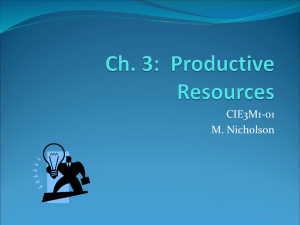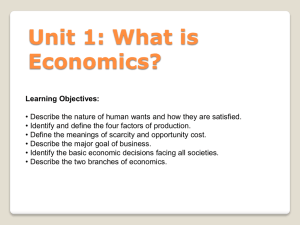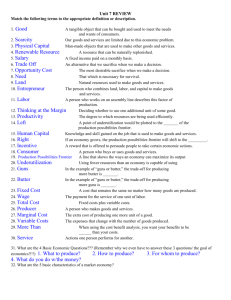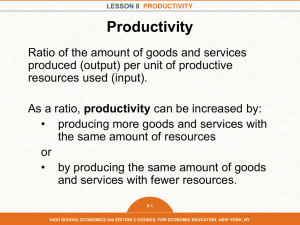CHAPTER 1
advertisement
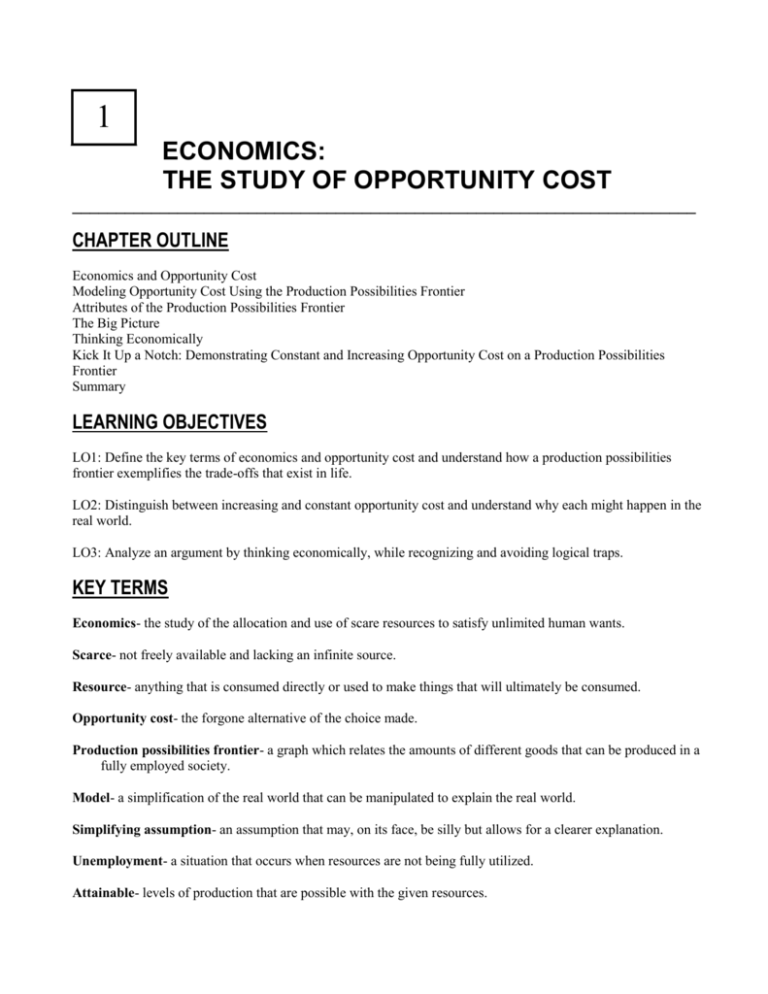
1 ECONOMICS: THE STUDY OF OPPORTUNITY COST _______________________________________________________________________ CHAPTER OUTLINE Economics and Opportunity Cost Modeling Opportunity Cost Using the Production Possibilities Frontier Attributes of the Production Possibilities Frontier The Big Picture Thinking Economically Kick It Up a Notch: Demonstrating Constant and Increasing Opportunity Cost on a Production Possibilities Frontier Summary LEARNING OBJECTIVES LO1: Define the key terms of economics and opportunity cost and understand how a production possibilities frontier exemplifies the trade-offs that exist in life. LO2: Distinguish between increasing and constant opportunity cost and understand why each might happen in the real world. LO3: Analyze an argument by thinking economically, while recognizing and avoiding logical traps. KEY TERMS Economics- the study of the allocation and use of scare resources to satisfy unlimited human wants. Scarce- not freely available and lacking an infinite source. Resource- anything that is consumed directly or used to make things that will ultimately be consumed. Opportunity cost- the forgone alternative of the choice made. Production possibilities frontier- a graph which relates the amounts of different goods that can be produced in a fully employed society. Model- a simplification of the real world that can be manipulated to explain the real world. Simplifying assumption- an assumption that may, on its face, be silly but allows for a clearer explanation. Unemployment- a situation that occurs when resources are not being fully utilized. Attainable- levels of production that are possible with the given resources. 2 Chapter 1 Unattainable- levels of production that are not possible with the given resources. Circular flow model- a model which depicts the interactions of all economic actors. Market- any mechanism by which buyers and sellers negotiate an exchange. Factor market- a mechanism by which buyers and sellers of labor and financial capital negotiate an exchange. Foreign exchange market- a mechanism by which buyers and sellers of the currencies of various countries negotiate an exchange. Goods and services market- a mechanism by which buyers and sellers of goods and services negotiate an exchange. Optimization assumption- an assumption that suggests the person in question is trying to maximize some objective. Marginal benefit- the increase in benefit that results from an action. Marginal cost- the increase in the cost that results from an action. Net benefit- the difference between all benefits and all costs. Positive analysis- a form of analysis that seeks to understand the way things are and why they are that way. Normative analysis- a form of analysis that seeks to understand the ways things should be. Incentives- something that influences a decision. Fallacy of composition- the mistake in logic that suggests that the total economic impact of something is always and simply equal to the sum of the individual parts. Direct correlation- a higher level of one variable is associated with a higher level of the other variable. Causation- a change in one variable makes another variable change. Counterfactual- an educated guess as to what would have happened had a policy or event not occurred. Inverse correlation- a higher level of one variable is associated with a lower level of the other variable. Economics: The Study of Opportunity Cost 3 PROBLEMS 1. (This problem includes a review of the basic techniques of graphing.) ____________ _____________ 0 _____________ _____________ GOODS PRODUCED PRODUCTION ALTERNATIVES A B C D E ______________________________________________________________________________________ Computers (hundreds of thousands) Hamburgers (millions) 0 32 1 24 2 16 3 8 4 0 ________________________________________________________________________________________________ a. When you draw a graph, the first step is to set up the scales on the vertical and horizontal axes allowing sufficient room to plot all the data points. In the example on the previous page, allow four squares for each unit of computers and a half square for each unit of hamburgers (or 2 hamburgers per square). Make sure that your scales on both axes are marked like a ruler, and 2 units have the same length throughout the entire axis. b. Label the horizontal axis “Computers” and the vertical axis “Hamburgers.” List the variables to be plotted and the units of measure in parentheses (if the unit differs from one). c. Plot the points of the production possibilities frontier on the graph connecting the points to form the curve. 4 Chapter 1 d. Examine the curve to see if the curve has a positive upward trend showing direct correlation (as one variable increases, the other variable also increases) or if it has a downward trend indicating inverse correlation (as one variable increases, the other variable decreases). What type of correlation exists between hamburger production and computer production? _______________________correlation 2. Use the data and graph from Problem 1 to answer the questions for Problem 2. Opportunity cost can be calculated by estimating the amount of one good, which must be given up in order to obtain one more unit of the other. Calculate OC = [amount you give up / amount you get] a. If the economy is at point C, what is the cost of one more unit of computers? _______________________________________________________________________________________ b. If the economy is at point D, what is the cost of one more unit of computers? _______________________________________________________________________________________ c. If the economy is at point D, what is the cost of one more unit of hamburger? _______________________________________________________________________________________ d. If the economy is at point C, what is the cost of one more unit of hamburger? _______________________________________________________________________________________ e. Use this curve and your answers to (a), (b), (c), and (d) to demonstrate the constant opportunity costs in this problem. ____________________________________________________________________ ____________________________________________________________________ f. Describe the shape of the PPF curve in Problem 1. ____________________________________________________________________ g. What is the characteristic of the resources, which causes the constant opportunity costs? ____________________________________________________________________ ____________________________________________________________________ h. On the graph in Problem 1, draw a point J that corresponds to full employment. i. On the graph in Problem 1, draw a point K that corresponds to unemployment. j. On the graph in Problem 1, draw a point L that is unattainable. Economics: The Study of Opportunity Cost 3. Below is a production possibilities table for pizza and soda. GOODS PRODUCED PRODUCTION ALTERNATIVES A B C D E ______________________________________________________________________________________ Pizza 0 3 6 9 12 Soda 40 36 28 16 0 ______________________________________________________________________________________ a. Plot the data in the graph on the next page. Place pizza on the horizontal axis and soda on the vertical axis. b. What are the assumptions on which this production possibilities frontier is based? ______________________________________________________________________ c. If the economy is at point C, what is the cost of one more pizza? ______________________________________________________________________ d. If the economy is at point D, what is the cost of one more pizza? ______________________________________________________________________ e. If the economy is at point D, what is the cost of one more soda? ______________________________________________________________________ f. If the economy is at point C, what is the cost of one more soda? ______________________________________________________________________ g. Use this curve and your answers to (b), (c), (d), (e), and (f) to explain increasing opportunity costs. ______________________________________________________________________ ______________________________________________________________________ ______________________________________________________________________ _____________ 5 6 Chapter 1 0 _____________ h. Describe the shape of the PPF curve. _______________________________________________________ ______________________________________________________________________ i. What is the characteristic of the resources, which causes the increasing opportunity costs? ______________________________________________________________________ _________________________________________________________________________________________ _________________________________________________________________________________________ j. Draw a point J that corresponds to full employment. k. Draw a point K that corresponds to unemployment. l. Draw a point L that is unattainable. 4. Name the three economic actors that participate in the circular flow model discussed in this chapter. 5. Name the three markets included in the circular flow model discussed in this chapter. 6. What happens in factor markets? 7. What happens in foreign exchange markets? 8. What two areas are exogenous or outside of (surrounding) the circular flow model discussed in this chapter? 9. Explain why most production possibility frontiers are bowed outward, away from the origin. Economics: The Study of Opportunity Cost 7 SELF TEST --- MULTIPLE-CHOICE QUESTIONS 1. Which of the following involves a tradeoff? a. studying for an exam. b. buying a DVD player. c. going to college. d. all of the above involve tradeoffs. 2. Economics is the study of a. how society makes choices given unlimited resources. b. increasing and decreasing opportunity cost. c. how we can totally satisfy our unlimited wants. d. how we satisfy unlimited human wants given scarce resources. 3. Points on a production possibilities curve a. are normative. b. have unemployment. c. are unattainable. d. are at full employment. 4. Which of the following terms is not part of the vocabulary that we use, when we can think like an economist? a. marginal analysis b. optimization assumption c. artificial intelligence d. incentives 5. You observe that the Federal Reserve lowers interest rates and that during the following month, the unemployment rate rises. You conclude that lower interest rates lead to higher unemployment. This would be an example of a. the tradeoff among economic goals. b. confusing correlation and causation. c. a normative statement. d. the fallacy of composition. 6. The United States stock market rose dramatically early in the year 2000, and it fell by the end of that year. This is an example of a(n) a. normative economic statement. b. optimization assumption. c. positive economic statement. d. incentive. 7. Which of the following would be a normative statement? a. The trade deficit must be corrected, if the United States is to remain competitive in world markets. b. In the year 2000, the unemployment rate was the lowest in over two decades. c. To help stimulate the economy, Congress has lowered tax rates. d. Stock prices are very volatile. 8 Chapter 1 8. The opportunity cost of going to college is a. the tuition that you pay. b. choosing a major and a minor. c. the tradeoff between taking economics or history. d. the income that you give up had you worked full-time after high school. 9. Economic models are a. duplicates of the real world. b. usually made of paper and wood. c. built with simplifying assumptions. d. useless unless they are complicated. 10. People respond to incentives, therefore, we would expect that if the average salary of economists rises 50 percent and the average salary of engineers increases 24 percent, a. students will shift majors from engineering to economics. b. students will shift majors from economics to engineering. c. students will prefer not to attend college. d. none of the above. 11. To illustrate unemployment, you would place a point a. on the production possibilities frontier. b. inside the production possibilities frontier. c. outside the production possibilities frontier. d. (a) or (b). 12. To illustrate the maximum production level for that output mix, you would place a point a. on the production possibilities frontier. b. inside the production possibilities frontier. c. outside the production possibilities frontier. d. (a) or (b). 13. To illustrate a production level that is unattainable, you would place a point a. on the production possibilities frontier. b. inside the production possibilities frontier. c. outside the production possibilities frontier. d. (a) or (b) 14. To illustrate a production level that is attainable, you would place a point a. on the production possibilities frontier. b. inside the production possibilities frontier. c. outside the production possibilities frontier. d. (a) or (b) 15. In order to put a down payment on a new car, John started saving 30 percent of his take-home pay, and his savings account has increased dramatically. He states, “The country would be a lot better off, if we all cut our spending by 30 percent.” This is an example of a. the tradeoff among economic goals. b. confusing correlation and causation. c. the fallacy of composition. d. an optimization assumption. Economics: The Study of Opportunity Cost 9 16. An assumption of the production possibilities frontier is a. unlimited resources. b. fixed technology. c. many, many goods are produced in the world. d. unemployment. 17. Economists make the optimizing assumption that consumers maximize their happiness given their income level. Consumers will take action when a. MB > MC b. MB < MC c. MB = MC d. (a) or (c) Use the following table to answer question 18 –19. GOODS PRODUCED PRODUCTION ALTERNATIVES A B C D E _______________________________________________________________________________________ Pizza Soda 0 3 6 9 12 40 36 28 16 0 _______________________________________________________________________________________ 18. If the economy is at point B, what is the cost of one more pizza? a. 3/8 b. 2 2/3 c. 3/4 d. 1 1/3 19. Use the data from Question 18. If the economy is at point B, what is the cost of one more soda? a. 3/8 b. 2 2/3 c. 3/4 d. 1 1/3 20. When some economic resources are better at producing one good than another, there is a. increasing opportunity cost. b. constant opportunity cost. c. decreasing opportunity. d. no opportunity cost. 21. Which of the following are NOT one of the actors in the circular flow model? a. firms b. households c. banks d. government 10 Chapter 1 22. Which of the following is NOT one of the major markets included in the circular flow model? a. market for goods and services b. stock market c. market for factors d. foreign exchange market 23. In which market in the circular flow model are interest rates determined? a. foreign exchange market b. goods and services market c. interest rate market d. factor market 24. In which market in the circular flow model are wage rates determined? a. foreign exchange market b. goods and services market c. labor market d. factor market 25. Which term below best describes the position of the natural environment in the circular flow model? a. surrounding b. endogenous c. inside d. integral 26. Production possibility frontiers tend to be bowed outward, because as production of a product increases, its opportunity cost a. decreases. b. is constant. c. increases. d. first decreases then increases. 27. A linear production possibility frontier means that the opportunity costs of the products a. are increasing. b. are constant. c. are decreasing. d. first decrease then increase. Economics: The Study of Opportunity Cost 11 SELF TEST --- TRUE / FALSE QUESTIONS T F 1. If we choose to go to college, we seek a higher income. This action is an example of the optimization assumption. T F 2. A production possibility curve that is a straight line illustrates constant opportunity costs. T F 3. Rational people act only if the marginal cost of an undertaking is less than the marginal benefit. T F 4. Low gas prices provide an incentive for people to drive sport utility vehicles. T F 5. Jobs in economics are high paying, so 50 percent of students choose this major. Many students graduate expecting to find a high-paying job, but not all students can find high-paying jobs. This is an example of the fallacy of composition. T F 6. On a hot day, the marginal benefit of a third soda is usually higher than the first soda. T F 7. The opportunity cost of spending 15 minutes looking for a parking space in the downtown area is identical for students with jobs making $10 an hour and for students with no part-time employment. T F 8. When the production possibility frontier is bowed away the tradeoff between the production of two goods is constant. T F 9. An example of an optimization assumption is a person doing his/her job to maximize the income they could earn. T F 10. If you take a ten o’clock class, you cannot work that morning. This dilemma illustrates the concept of opportunity cost. T F 11. The circular flow model is a model that shows the interactions of all economic actors. T F 12. Households are a very important market in the circular flow model. T F 13. Wage rates are determined in the foreign exchange market. T F 14. Borrowers and savers interact in the goods and services market. T F 15. The natural environment surrounds the circular flow model. T F 16. International trade is facilitated by what takes place in the market for goods and services. 12 Chapter 1 ANSWERS TO STUDY QUESTIONS PROBLEMS 1. a-c. See graph below: P RO D UCTI O N P O S S I B I LI TI E S F RO N TI E R hundreds of thousands Hamburgers Constant Opportunity Costs 40 30 * L 20 J 10 *K 0 0 1 2 3 Computers millions 4 5 d. Inverse (negative) correlation 2. a. (16 - 8) / (3 - 2) = (8 units Hamburgers / 1 unit Computers) = 8 units of Hamburgers b. (8 - 0) / (4 - 3) = (8 units Hamburgers / 1 unit Computers) = 8 units of Hamburgers c. (3 - 2) / (16 - 8) = (1 Computer / 8 units Hamburger) = 1/8 unit of Computers d. (2 - 1) / (24 - 16) = (1 Computer / 8 units Hamburger) = 1/8 unit of Computers e. As computer output increased from 2 to 3 and then from 3 to 4, the opportunity cost remained a constant 8 units of hamburgers. As hamburger output increased from 8 to 16 and then from 16 to 24, the opportunity cost remained a constant 1/8 units of computers. Opportunity cost remains constant throughout this problem. f. A straight line g. The resources are equally skilled at the production of both products. Economics: The Study of Opportunity Cost 13 3. P RO D UCTI O N P O S S I B I LI TI E S F RO N TI E R Increasing Opportunity Cost 50 Soda 40 *L J 30 20 *K 10 0 0 2 4 6 8 Pizza 10 12 14 b. The assumptions are two goods in the economy, a fixed number of resources, fixed technology, and full employment. c. (28 - 16) / (9 - 6) = (12 units Soda / 3 units Pizza) = 4 units of Soda d. (16 - 0) / (12 - 9) = (16 units Soda / 3 units Pizza) = 5 1/3 units of Soda e. (9 - 6) / (28 - 16) = (3 units Pizza / 12 units Soda) = 1/4 units of Pizza f. (6 - 3) / (36 - 28) = (3 units Pizza / 8 units Soda) = 3/8 units of Pizza g. As we add more resources to the production of pizza, we are using fewer resources to produce soda. As we move from 6 to 9, and then from 9 to 12 units of pizza, the opportunity cost of 1 unit of pizza increased from 4 to 5 1/3 units of soda. As production of soda increased 16 to 28, and then from 28 to 36, the opportunity cost increased from 1/4 to 3/8 units of pizza. h. Bowed out away from the origin. i. Not all resources are alike. Some resources are better at soda, and some resources are better at pizza. 4. The actors included in the circular flow model include: firms, households, and government. 5. The three markets in the circular flow model include: factors, goods and services, and foreign exchange (currency). 6. Factor markets are where workers and firms interact to determine wage rates and where borrowers and savers interact to determine interest rates. 7. Foreign exchange markets are where holders of currency issued by various countries interact to facilitate international trade by determining the price of one currency in terms of another currency. 8. “The rest of the world” and the “natural environment” are exogenous to or surround the circular flow model. 14 Chapter 1 9. Production possibility frontiers are bowed outward, because the opportunity cost of a product increases with increasing production of that product. This occurs because some resources are better than other resources at producing any particular product. MULTIPLE-CHOICE QUESTIONS 1. 2. 3. 4. 5. D D D C B 6. 7. 8. 9. 10. C A D C A 11. 12. 13. 14. 15. B A C D C 16. 17. 18. 19. 20. B D B C A 9. 10. 11. 12. T T T F 13. 14. 15. 16. F F T F TRUE / FALSE QUESTIONS 1. 2. 3. 4. T T T T 5. 6. 7. 8. T F F F 21. 22. 23. 24. 25. C B D D A 26. C 27. B

